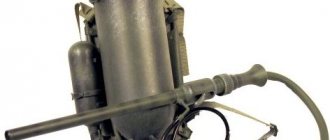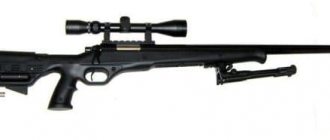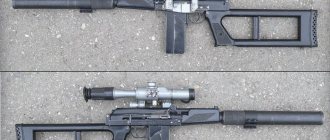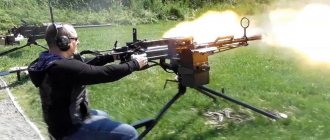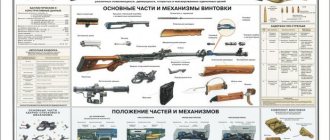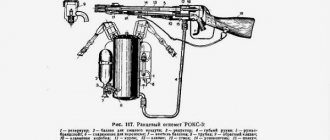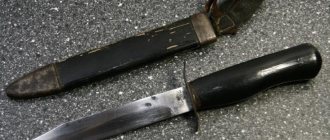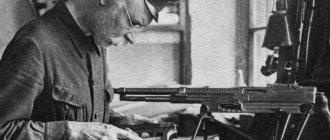RPO "Lynx" - rocket-propelled infantry flamethrower
RPO "Lynx" is a rocket-propelled infantry flamethrower "Lynx", designed to destroy hidden firing points, lightly armored and automotive vehicles, destroy manpower, and create fires. Developed in Tula at the Instrument Design Bureau. Adopted into service in 1975. At the end of the 1980s, the RPO “Lynx” was replaced by the more modern RPO-A “Shmel” flamethrower.
History[edit]
By the beginning of the 1970s, the command of the Soviet Army raised the question of replacing the backpack jet flamethrowers that were in service with a fundamentally new weapon - jet flamethrowers due to the short range and vulnerability of the former. More than once or twice, assault troops died due to a single bullet or shrapnel hitting a cylinder with a fire mixture, so one of the main requirements for the new weapon was safety during transportation.
The Lynx flamethrower was actively used in the Afghan war, especially at its initial stage. However, it was soon supplanted by a much more effective and deadly weapon - the Shmel RPO.
Video of the Lynx flamethrower
The Lynx flamethrower became the first Soviet jet flamethrower, which began to replace the army LPO-50 jet flamethrower. The RPO "Lynx" was 10 times longer in range than its jet predecessor, the second advantage was that the fuel was ejected in a special container, which scattered when it hit the target, and in a conventional backpack flamethrower a lot of the mixture burned at a long distance until it reached the target. Another plus was that after the shot the shooter gave away his position much less and immediately threw off the shot container, becoming more mobile. For ease of shooting from a prone position, there was a bipod.
The main purpose of the RPO "Lynx" was to create fires, fight lightly armored vehicles and "smoke out" enemy personnel from cover.
When creating the RPO-Lynx, units from the RPG-16 anti-tank grenade launcher were taken. The flamethrower consisted of a reusable launcher with an aiming device and connected disposable containers with the fire mixture charges themselves, which were brought in blizzards of 2 pieces, the weight of one container was 11 kg. The launcher's lifespan is more than 100 shots. The fighter connected the container to the installation and could shoot accurately up to 850 meters, depending on the sight, the maximum shot range was 1000 meters. When fired from the barrel, the capsule with the charge was thrown out by a solid fuel engine, which burned in the barrel bore, simultaneously setting fire to the capsule with the mixture. Having reached the target and hit, the detonator exploded, which sprayed 4 liters of the fiery mixture by inertia 30-40 meters forward and 3-4 meters wide.
In the near future, RPO "Shmel" began to come into the manger of RPO "Lynx", which was smaller, more compact and completely disposable. At the moment, RPO-Lynx is available in military warehouses of the Russian Federation and the countries of the former USSR.
Modifications
“Lynx-Z” – incendiary ammunition, capsule with fire mixture MPS-1A. Causes fires and fire damage. According to the manufacturer, the impact of the ammunition is equivalent to the explosion of a 122 mm artillery shell. Fire mixture volume – 4 l (3 kg)
“Lynx-D” is a smoke munition that causes smoke in a volume or space.
The bite of the Lynx and the flight of the Bumblebee
The end of the 60s in the Soviet chemical forces marked the end of the long career of jet infantry flamethrowers. To replace them, a flamethrower of a fundamentally different design was required - in 1975 it became the RPO “Lynx”.
Lynx bite
Despite the rapid obsolescence of jet infantry flamethrowers, a new generation of “fire-breathing” weapons appeared in the Soviet weapons system in the 50s. Light and heavy infantry flamethrowers LPO-50 and TPO-50M were produced in the USSR until the 80s. However, already at the end of the 60s, the issue of increasing the effectiveness of such weapons arose, the main drawback of which was the short flamethrowing range (several tens of meters).
To solve a difficult problem, in 1968, in the interests of the troops of the Radiation, Chemical and Biological Defense Forces (RKhBZ), development work (R&D) “Lynx” was opened. The development of the new flamethrower was carried out at the Tula Instrument Design Bureau (KBP), which was engaged in the design of launchers for rocket-propelled grenade launchers. For the new weapon, Tula experts decided to use the TKB-034 impact mechanism from the RPG-16 grenade launcher. The impact mechanism mounted on the barrel, along with sights and a bipod, became the MO251 gun for throwing a flamethrower capsule.
RPO MO25-1 as part of the MO251-1 shotgun (below) and the MO252-1 shot (above)
Image source: forum.guns.ru
The finally equipped flamethrower capsule, together with the expelling engine, was placed in a sealed container, thus making up the MO252 flamethrower shot. The low-viscosity napalm fire mixture MPS-1A is placed in a thin-walled capsule and ignites during flight. To fire a shot from a flamethrower, it is enough to attach the container to the gun. This modular arrangement today is most typical for one of the most modern RPG-32 grenade launchers. As they say, the new is the well forgotten old.
As a result, the infantry jet flamethrower (RPO) under the symbol MO25 was adopted by the USSR RCBZ troops in 1975. For ease of carrying, two containers can be connected into a pack to which a gun can be attached. Such a 22-kilogram load was supposed to be carried by a flamethrower in a stowed position. Serial production of pilot batches of RPO was carried out in the Tula KBP. Subsequently, the gun was produced at a factory in Vyatskie Polyany, and the shots were fired at a factory hiding under the digital code designation 93.
Shooting from RPO "Lynx"
Image source: vsr.mil.by
By the beginning of the 80s, the RPO flamethrower had undergone minor modernization. The shot had a new ejector engine, which made it possible to increase the target firing range from 190 to 250 m. The modernized flamethrower received the index MO25-1, the gun with new sights - MO251-1, and the shot itself began to be designated as MO252-1.
Flight of the Bumblebee"
RPO “Lynx” received its baptism of fire during the war in Afghanistan. Despite the successful use of the new generation of flamethrowers in military conflict, its shortcomings have also emerged. To fight gangs in mountainous conditions, more effective weapons were required. At the same time, work on modernizing the RPO in Tula began back in 1976 as part of the Shmel R&D project.
Transportation options and firing techniques from the RPO-A
Image source: missilery.info
The concept of the new flamethrower excluded the modularity of the weapon in favor of the well-proven design of single-use grenade launchers. This option greatly simplified the use of the flamethrower for its intended purpose. While maintaining the option of transporting two flamethrowers in one pack, it was assumed that the ammunition load would consist of two options for equipping the capsule. In addition to the usual incendiary ammunition, they began to develop a smoke version of the equipment. This is how two variants of flamethrowers appeared - RPO-Z and RPO-D.
New metallized mixtures began to be used to load ammunition. The RPO-Z uses an OM-12 incendiary mixture, and the RPO-D uses a smoke-incendiary mixture (OM-419). Such ammunition, with half the active substance mass, turned out to be more effective. The design of the ammunition made it possible to increase the firing range and hit accuracy several times.
Design of the RPO-A flamethrower and three options for loading ammunition
Image source: roe.ru
To use flamethrowers in low light conditions, the Bumblebee kit included an OPO optical sight with a firing range of up to 450 m. Another version of the OPO-1 sight made it possible to fire at a range of up to 850 m, and the presence of illumination in its design allowed the flamethrower to be used at night conditions. Given the undoubted advantages of equipping flamethrowers with OPO and OPO-1 devices, it is extremely difficult to find such options in the army.
R&D “Bumblebee” was divided into two parallel directions. The first and classic design work for flamethrowers was the Shmel-1 R&D for the development of smoke and incendiary ammunition, the second was the Shmel-2 R&D, within which the OM-100 mixture with completely different characteristics was developed. It was the second version of the RPO-A flamethrower with thermobaric ammunition that became a priority, and the modification of the first “Shmel” lasted until 1989.
Unusual RPO
It was the RPO-A that was the first of the “Bumblebee” family to be adopted into service as a new generation flamethrower in 1984. At the same time, the RPO-A structurally became not so much a flamethrower as a disposable thermobaric grenade launcher. This version of the flamethrower is most effective when destroying the enemy indoors and confined spaces. At the same time, due to its properties, the thermobaric mixture does not contribute to the occurrence of fires, but, instantly burning oxygen, acts on the principle of a fire extinguisher.
It was this version of the RPO that was destined to become the most widespread modern Soviet and Russian infantry flamethrower. In addition to its use by Soviet troops in Afghanistan and the Russian military in Chechnya, the RPO-A was actively used in various special operations in the North Caucasus. The most famous and high-profile use of RPO-A by Russian special forces was the storming of a school in Beslan during a special operation to free hostages.
Ammunition device RPO-A (top), RPO-Z and RPO-D (bottom)
Image source: I. Kochin
From the materials of the parliamentary commission investigating the terrorist attack in Beslan, it became clear that the use of RPO-A did not lead to the emergence of fires, which caused the main casualties among the hostages. It has also been established that the action of thermobaric ammunition leads to a flash lasting less than 0.5 seconds with a radius of about 3 m with a temperature of about 1623 K. Already at a distance of more than 5 m from the explosion site, a person receives injuries that are not life-threatening and are accompanied by temporary health disorders.
A number of simulators have been developed for training in shooting from the RPO-A flamethrower: 7.62-mm PUS RPO-A(M), 5.6-mm small-caliber MOT-A and the cool electronic 9F700-2. In Ukraine, in 2022, they presented their own version of the RPO-A under the name RPV-16 (RPO-16). The differences from the Soviet-style flamethrower are a reusable starting device and a modernized ammunition fuse (PRPV-16 or V17K instead of V-695 or U-505Sh). Their own versions of “Bumblebee” are produced in China and North Korea.
Flamethrower RPV-16
Image source: Ukroboronprom
New stream
In the early 2000s, a modernized Shmel with increased range and power appeared. The new RPO PDM-A “Priz” has no fundamental differences from the RPO-A, but has a reusable starting device and an additional telescopic barrel. This design almost doubles the length of the launcher during firing and allows it to achieve an impressive 1.7 km maximum firing range.
Flamethrower RPO PDM-A
Image source: recomonkey.com
To increase the efficiency and accuracy of firing from the RPO PDM-A, a number of optical devices have been developed. Among them are the flamethrower's night sight (PON) and the all-day automated optical sight (VAOP). The latter is equipped with a laser rangefinder, a ballistic computer, a charge temperature sensor and ensures detection and engagement of targets at a range of up to 1500 m at any time of the day. At the same time, the flamethrower launcher allows the installation of other optical devices. However, as in the case of the OPO and OPO-1 sights for the RPO-A, such configuration options are more often found at exhibitions and demonstration shooting than directly in the troops.
In 2003, the RPO PDM-A “Priz” was adopted into service with the Russian RCBZ troops, and two years later, the Varna jet infantry flamethrower (SPO) also appeared among the standard flamethrowers. It would seem that there has been a return to the classic design of the LPO-50 flamethrower, but this is not so - the design of the SPO ammunition is closer in its properties to the ancestor of the Soviet capsule flamethrowers RPO "Lynx". At the same time, the design of the starting device remained the same as that of the RPO-A Shmel.
Shooting from SPO "Varna"
Image source: popmech.ru
You can distinguish “Varna” from “Bumblebee” by the marking in the form of two red intersecting stripes on the end cap of the flamethrower (RPO-A has two red stripes, RPO-Z has one red stripe, and RPO-D has one yellow stripe). The Varna's ammunition ignites in flight, like that of the Lynx, while the fire mixture is enclosed in a soft-walled container made of metal mesh. In such a flaming container, a stream of fire is directed at the target from the launch tube of a flamethrower using an expelling engine. This happens in a similar way to jet flamethrowers of the previous generation, where flamethrowing took place under pressure from balloon tanks.
Having increased the efficiency of creating fires (the main purpose of a flamethrower), we had to sacrifice the range of delivery of the fire mixture to the target. She returned to the performance of jet backpack flamethrowers and barely exceeded a hundred meters. At the same time, it again became possible to use a flamethrower from shelters and rooms at a distance of one meter from the obstacle behind the flamethrower. Thus, the flamethrower is currently armed with a whole complex of 93-mm ammunition for various purposes, the basis of which was laid by the developers of the RPO “Lynx” almost half a century ago.
Technical characteristics of grenades
| RPO | RPO-Z | RPO PDM-A | SPO | |
| Index | MO25 | MO.1.03.00 | MO.1.05.00 | MO.1.09.00 |
| Caliber, mm | 93 | 93 | 90 | 93 |
| Length, mm | 1440 | 920 | 922 | 920 |
| Weight, kg | 12,1 | 11 | 8,8 | 8,1 |
| Weight of fire mixture, kg | 4 | 2,1 | 3,5 | 2,5 |
| Type of fire mixture | MPS-1A | OM-12 | OM-100MI | OM-12 |
| Weight of a pack of two flamethrowers, kg | 22 | 22 | 19 | 16,2 |
| Sighting range with mechanical sight, m | 190 / 250 | 600 | 800 | 70 |
| Maximum firing range, m | 400 | 1200 | 1700 | 120 |
Sources:
- Infantry jet flamethrower MO 25.000, MO 25-1.000. Technical description and operating instructions MO 25.000, MO 25-1.000 TO
- Shooting manual. 93-mm rocket-propelled infantry flamethrower (RPO-A)
- Rocket infantry flamethrower. MO.1.02.00, MO.1.03.00, MO.1.04.00 TO
- Infantry jet flamethrower with increased range and power in thermobaric equipment RPO PDM-A. Technical specifications MO.1.05.00.00.000 TU
- Shooting training device PUS RPO-A(M). Operating manual for PUS RPO-A(M) RE
Ruslan Guk
Tactical and technical characteristics of RPO "Lynx"
Adopted: 1975 Length, mm: 1440 (in combat position) Rate of fire, rounds/min: 1 Sighting range, m: 190 Maximum range, m: 400 Direct shot range at a target 2 m high: 130 m Time to transfer to combat position : 60 sec Type of fire mixture: MPS-1A Volume of fire mixture in one shot: 4 l Weight of pack with gun: 22 kg Weight of loaded flamethrower: 12.6 kg Weight of flamethrower shot: 9.4 kg Weight of gun: 3.2 kg Warranty life of gun : 100 shots
